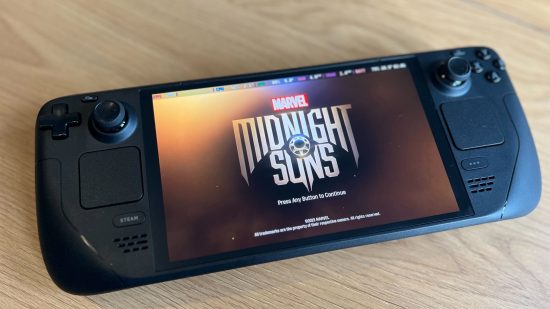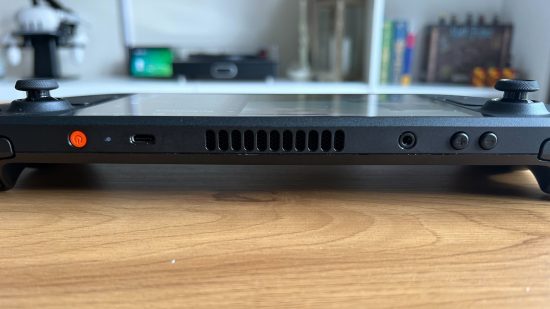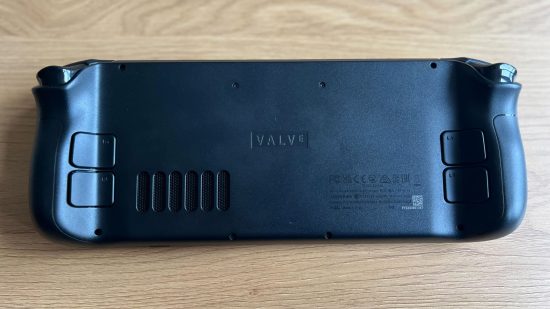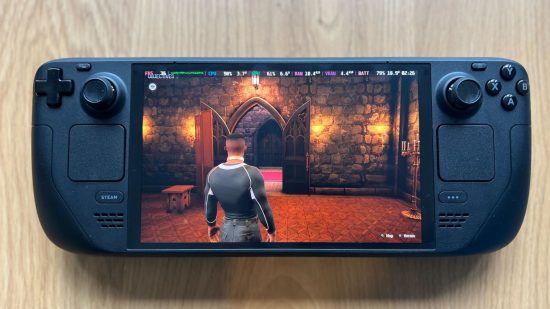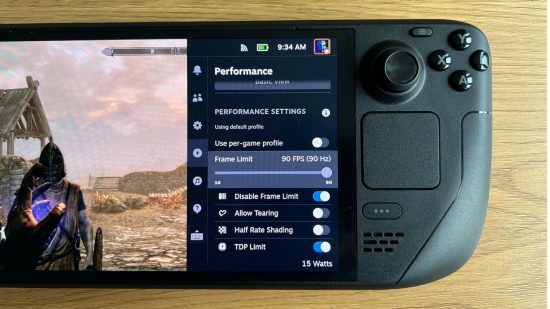Our Verdict
The Steam Deck OLED is the premier PC gaming handheld. Yes, there are more powerful options out there, whether from big market names like the ROG Ally or niche brands like Ayaneo, but no other gaming handheld comes close to the Steam Deck OLED display and performance efficiency.
- Vibrant OLED HDR display
- Improved battery life
- Retains everything great about the original Steam Deck
- Limited storage options
- No design variety
The Steam Deck OLED isn’t the most powerful gaming handheld on the market, but it is the best. So often in PC gaming, power and performance are the central driving forces behind determining whether a product is worth buying. Whether it’s the latest and greatest graphics card offering from Nvidia or AMD’s latest CPU masterpiece, PC gaming is often tunnel-visioned on ensuring the dollars you spend return those valuable extra frames in games. Why, then, is a product like the Steam Deck OLED so easy to point to as the best PC gaming handheld?
It’s simple. Valve created a device that offers a level of convenience that is irresistible. At its core, just like the LCD model, the Steam Deck OLED is a portable gaming console that puts a library of games bigger than that of the Nintendo Switch right at your fingertips. Only now, it’s got the best display, improved battery life, and fractionally better performance to iron out the creases that have seen the LCD model fall down the pecking order.
Why you can trust our advice ✔ At Pocket Tactics, our experts spend days testing games, phones, tech, and services. We always share honest opinions to help you buy the best. Find out how we test.
Price and availability
The 512GB Steam Deck OLED costs $539 / £479, while the 1TB model I used for this review costs $649 / £569. As things stand, the only way to purchase a Steam Deck OLED is directly through Valve.
It’s possible to buy the original 256GB Steam Deck LCD through multiple retailers, including Amazon, and it has received a price drop to $399 / £349 following the release of the OLED. Valve has discontinued the 64GB eMMC model entirely, meaning the only way to obtain one is through the second-hand market or leftover new stock still with retailers.
Specs
| CPU | AMD Zen 2 (6nm) |
| GPU | AMD RDNA 2 |
| RAM | 16GB LPDDR5 (6,400MR/s) |
| Display | 7.4 inch OLED, HDR, 1280×800, 90Hz |
| Battery | 50WHr |
| Storage | 512 or 1TB NVMe SSD |
| Weight | 640g |
| Size | 298mm x 117mm x 49mm |
Looking inside the Steam Deck OLED, it becomes apparent that while this isn’t the generational leap forward most expected, there are still some sizeable improvements compared to the LCD model.
The HDR OLED screen, with a new max refresh rate of 90Hz, is arguably the most significant upgrade, and with no other major competitor releasing an OLED model, it still comfortably has the best display on the market. On top of this, the new 6nm processing spec on the AMD Zen 2 APU allows for fractional performance benefits in part due to better optimization. A bumper factor in any performance increase would be the faster RAM specs, with a 900MT/s increase in the OLED.
Another substantial change is the larger 50WHr battery. This upgrade equates to anywhere between 3-12 hours compared to the 2-8 of the LCD. It’s not the biggest battery on the market, but working alongside all the other specs, it again succeeds thanks to strong optimization.
Features
Top line features of the Steam Deck OLED include a 7.4-inch 1280 x 800 HDR OLED screen with a refresh rate of up to 90Hz and anti-glare etched glass. Valve has optimized the 7nm APU down to a 6nm alternative, which, while offering little outright performance benefit, does aid general optimization that has paved the way for a better overall experience.
The Steam Deck OLED utilizes an improved 50WHr battery to extend gameplay for up to 12 hours, depending on the game you’re playing and the configuration of both the GPU clock and TDP limit. The Steam Deck OLED also adopts Wi-Fi 6E, allowing faster downloads and a more stable online connection.
SSD storage is now the only option available with the 512GB or 1TB versions, although it is still expandable via external SSD or microSD. You get a hard shell carry case with both models for added protection on the go. The OLED also features a dedicated Bluetooth antenna, allowing multiple controller connections while improving the latency of connected devices like headsets.
Design
The running trend of the Steam Deck OLED is that beyond some major improvements that are performance driven, rather than overtly obvious to the naked eye, there’s very little to distinguish the OLED and LCD models.
However, the OLED display is .4 inches bigger while feeling slightly lighter. Other than this, they are identical. Dual touchpads feature on either side of the display and contain haptic feedback, while the joysticks are in a symmetrical configuration.
Face buttons mimic the Xbox layout, while standard bumpers and triggers adorn the top of the Steam Deck OLED. The control scheme features a d-pad squeezed in next to the right thumbstick, quite awkwardly, in all honestly, but you can adjust the grip to reduce the chance of misclicking. The star of the controls are the four back buttons, which sit so naturally into a standard controller grip that makes using them surprisingly simple and almost encouraged.
On audio, there are two small speakers on either side of the display in the lower third of the console, and the quality is fairly average, but you can connect a Bluetooth or a 3.5mm headset to compensate for this.
The OLED disperses heat through two vent locations, one on the top, placed between the volume controls and 3.5mm jack on the left, and the USB-C charging port and power button on the right, while the other is on the back of the console. You can find a microSD card slot for extra storage tucked away in the right-hand corner of the bottom of the device.
Display
The Steam Deck OLED’s name is a giveaway in terms of its biggest and best feature. This 7.4-inch display is incredibly vibrant, putting many other handheld displays to shame.
Devices like the PS Vita attempted OLED screens before, and it’s likely that the tech simply wasn’t ready or as widely appreciated. The Steam Deck suffers from no such side effects. I’m lucky enough to have bypassed the Steam Deck LCD and used an OLED first, but moving back to view the original screen, I’m not sure I could ever downgrade in the long term.
Adding HDR on top of the OLED quality almost seems unfair to competitors, all of whom are still using traditional LCS displays, granted some are using VRR (variable refresh rate), like the ROG Ally, which isn’t possible on the Deck.
The touchscreen aspect of the display is also outstanding. Over weeks of testing, there has yet to be an issue of poor responsiveness or miscalibration where the device registers a touch in a location adjacent to where your finger hits the screen. While the Steam Deck OLED doesn’t use Gorilla Glass for durability like the ROG Ally, it’s also not easy to leave marks and even harder to cause any scratches or damage.
All-in-all, while the Steam Deck OLED might not have the edge when it comes to raw power, no other display on the market comes anywhere close to the quality that Valve packed into this handheld.
Battery
Having already alluded to the improved 50WHr battery within the Steam Deck OLED, the change equates to a 30-50% increase over the LCD model. However, this battery life increase is based purely on the games you are playing and the power they consume.
Refinements made to how the Steam Deck OLED consumes power also play a huge role in the overall improvements to this new model. Sticking a bigger battery in is one thing, but making sure it holds up to the demands of the average gamer is another ballgame.
Pushing for better graphical performance in games is bound to create a larger power draw for the Steam Deck OLED, thus shortening the battery life. This becomes apparent when playing older games on Steam, as the expected battery life, even on higher settings, tends to be much longer. When playing a more recent or graphically demanding game, the expected length of time is dramatically shorter.
You have a level of control over the battery to take certain performance-related actions, which we’ll cover in greater detail later on, and extend this expected life cycle. However, it always comes at a cost in-game.
The biggest battery on the PC handheld market will feature in the MSI Claw, an upcoming handheld with a 53WHr battery. With such a small gap between the Steam Deck OLED and the top-on-class choice, it shows that Valve responded to the initial complaints about the longevity of its LCD console. Using the Steam Deck OLED while plugged in and charging is possible but can be quite restrictive and nullify the core identity of a portable gaming device.
Performance
Let’s be clear from the off here: you won’t be running new games with high graphical settings on the Steam Deck OLED, or any gaming handheld for that matter, not without the help of an external graphics card at least, but there are refinements made to this model to try and draw a little more power over its predecessor.
These refinements are largely due to speedier memory and general efficiency improvements. In real terms, this equates to an absolute max performance increase of 10% over the LCD model. Any improvement will present itself as an increased frame rate which, depending on the game you’re playing, only adds up to between 1-5 fps.
Valve has made a very smart play in choosing to transition to the Steam Deck OLED as the new flagship model, but there are questions worth asking about the lack of a meaningful performance increase. Perhaps it is a sense of customer entitlement, believing that a new product should ultimately bring more power to the table. Still, given how much better the display and battery are, marginal performance gains are forgivable when looking at the bigger picture.
Another reason we can forgive the limited performance increase is the unrivaled convenience of SteamOS. Having your Steam library at your fingertips and ready to go with zero additional effort is a benefit we can’t understate.
Better still, the Valve verification process lets you know when a game is playable or fully verified, giving you complete transparency of what to expect. Playing your PC games has never been easier, and it hasn’t taken long for developers to understand the importance of these handheld devices.
Take the Yakuza series as an example. All the games, including the Like A Dragon spin-offs, are all Steam Deck verified and perform better on the Steam Deck OLED – a clean and stable 60 fps of medium settings – than they will on some low-end budget PCs and laptops. Ryu Ga Gotoku is now renowned for making its games perfect on Steam Deck, thus creating a healthier relationship with fans of the games and newcomers alike.
Whether a developer has optimized a game for Steam Deck or not, there are still aspects of the performance that you can control. These changes don’t just to improve your experience but also to make your battery last longer. You can cap the display’s frame rate while limiting the power or GPU clock speeds and TDP, essentially limiting the power the APU can use.
This change impacts performance in-game and may force you to drop the graphical quality, but it’s a surefire way to make your game time last longer.
Should you buy the Steam Deck OLED?
Given how convenient the SteamOS is and that it’s below the typical $700 price point many competitors are still pushing, it’s hard not to recommend the Steam Deck OLED. With a fresh generational advancement likely not coming for a few years, you can safely purchase a Steam Deck OLED without the fear of Valve replacing it with a superior device before you’ve truly gotten your money’s worth.
While some will despair that SteamOS was an impractical way to approach the Deck’s operating system. Instead, it brings a level of stability that will make it easy for casual gamers to navigate, while those who wish to stray off the beaten path to fully explore this Linux-based OS are free to do so.
There are enough improvements over the standard LCD model to have justified a substantial price increase. Yet, the Steam Deck OLED still sits well below its competitors, creating a value gap that is hard for anyone to overcome. While everyone else fights to make the best handheld for $700, Valve continues to push its groundbreaking console for up to $160 less.
Money spent on other devices is far from wasted, but there’s very little that other handhelds can do that the Steam Deck OLED can’t also achieve. A true generational leap still appears to be years away, so investing in a Steam Deck OLED now is one of the most intelligent decisions you can make. If you’re lucky, you might actually start to work through your gaming backlog.
Alternatives
If you’re still not sold on the Steam Deck OLED or are in true pursuit of power, then there are some alternative products that you could look to to satisfy your portable PC gaming needs.
ASUS ROG Ally
The ROG Ally is quite often seen as #2 in the rankings by many, typically because it’s the next highest-profile PC gaming handheld and has been around for a similar amount of time compared to the Steam Deck LCD. It’s natively more powerful than the Steam Deck OLED, but doesn’t run on SteamOS and only features an LCD screen, for $699 / £599. For more on this one, check out our ASUS ROG Ally review.
Lenovo Legion Go
The Legion Go is the only other alternative to the Steam Deck OLED that has a big-name brand behind it, at least until the MSI Claw A1M launches. While the Legion Go is still finding its feet in the handheld gaming market, it comes packed with power and sits at the same $699 / £699 price point as the Ally.
